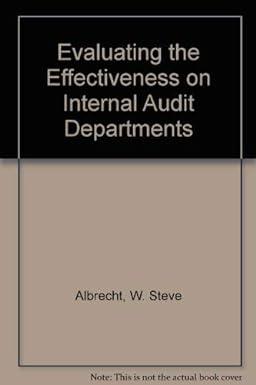Question
Auditors employ a variety of sampling techniques, both statistical and non-statistical, to select test transactions during the audit process. The choice of sampling method depends
Auditors employ a variety of sampling techniques, both statistical and non-statistical, to select test transactions during the audit process. The choice of sampling method depends on the specific audit objectives and the nature of the population being audited. Statistical Sampling Methods Statistical sampling methods are based on probability theory and provide a quantitative measure of the risk of sampling error. These methods are typically used when the population is large and homogeneous, and the auditor wants to make inferences about the entire population based on the sample results. Examples of statistical sampling methods include: Random sampling - Each item in the population has an equal chance of being selected for the sample. Systematic sampling - Every nth item in the population is selected for the sample. Stratified sampling - The population is divided into subgroups (strata), and samples are selected from each stratum.
Non-Statistical Sampling Methods Non-statistical sampling methods are not based on probability theory and do not provide a quantitative measure of sampling risk. These methods are typically used when the population is small or heterogeneous, or when the auditor wants to focus on specific items that may be of interest. Examples of non-statistical sampling methods include Judgmental sampling - The auditor selects items for the sample based on their judgment and experience. Convenience sampling - The auditor selects items for the sample that are readily available. lock sampling - A group of consecutive items is selected for the sample. Impact of Significant Events or Transactions on Financial Statements Significant events or transactions are those that have a material impact on the financial statements. Auditors must pay particular attention to these events or transactions to ensure that they are properly recorded and disclosed. The sampling method used to audit significant events or transactions will depend on the specific circumstances. For example, if a company has a large number of related-party transactions, the auditor may use stratified sampling to ensure that a representative sample of these transactions is included in the audit.
Challenges of Using Non-Statistical Sampling Methods The main challenge of using non-statistical sampling methods is that they do not provide a quantitative measure of sampling risk. This means that the auditor cannot be sure how confident they can be in the conclusions they draw from the sample results. Additionally, non-statistical sampling methods are more susceptible to bias, as the auditor may be more likely to select items that are easy to access or that they believe are more likely to contain errors.
Step by Step Solution
There are 3 Steps involved in it
Step: 1

Get Instant Access to Expert-Tailored Solutions
See step-by-step solutions with expert insights and AI powered tools for academic success
Step: 2

Step: 3

Ace Your Homework with AI
Get the answers you need in no time with our AI-driven, step-by-step assistance
Get Started


